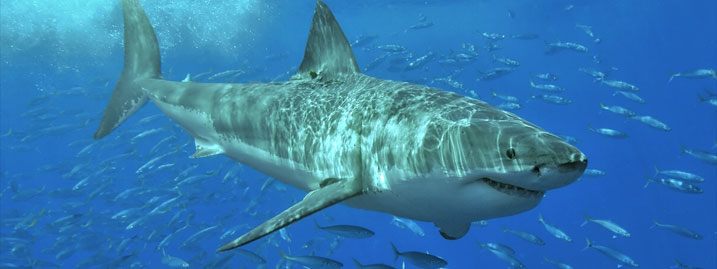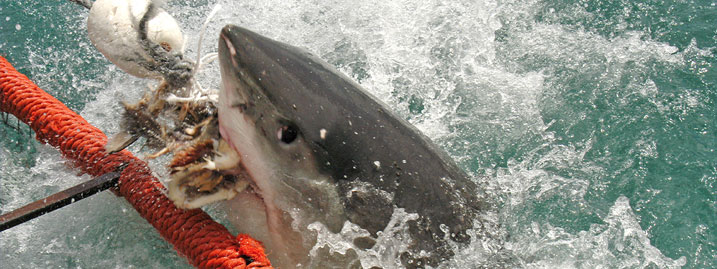
How common are they and what would you do if you were involved in a SHARK ATTACK?
Every year over 70 shark attacks are reported worldwide. Despite their relative rarity many people fear shark attacks thanks to horror fiction and films, such as the Jaws series and actual dreadful serial attacks, such as the Jersey Shore attacks of 1916. Did you know that there are more than 480 shark species, but curiously only 4 are responsible for the recorded fatal, unprovoked attacks on humans? These are the Great White, Tiger, Bull and Oceanic Whitetip. The statistics might be scary but just compare them with the number of deaths from other, less feared causes: - an average of more than 38 people die annually from lightning strikes in coastal states of the USA and the annual number of people who drown is around 3,300, while less than 1 person a year dies from a shark attack.

Where do they happen?
The USA and Australia (Western Australia in particular) are the countries with the highest number of shark attacks and the highest number of fatalities. South Africa also has a high number of both attacks and fatalities. But the actual number of shark attacks remains uncertain as the majority of Third World coastal nations have no method of reporting suspected shark attacks, which often remain unsolved or unpublicised.
Types of attack
Shark attacks are normally describes as “provoked” or “unprovoked”.
Provoked attacks are those on humans who are perceived as a threat to the shark or a competitor to its food source. They often occur when a human touches a shark, pokes it, teases it, spears, hooks or nets it. Sometimes the provocation can be accidental, such as a surfer hitting a shark with his surf board. In these cases the shark can clearly be understood as defending himself.
Unprovoked attacks are initiated by the shark without human provocation and they can normally be separated into three types:-
- Hit-and-run - usually not fatal. The shark bites and then leaves. Most victims don’t even see the shark. These often occur in the surf zone or in murky water and are believed to be the result of mistaken identity.
- Sneak attack – often carried out with the intention of preying on the victim who will often not see the shark and may sustain multiple deep bites. This type happens rarely, but can occur in places such as South Africa where sharks are accustomed to human presence. These attacks are the most fatal.
- Bump-and-bite attack. The shark circles and bumps the victim before biting. It is believed that the Great Whites do this as a test bite in order to identify what is being bitten. If the victim panics and thrashes about the shark may believe that he is definitely prey and bite repeatedly and often fatally.
Why do sharks attack humans?
Sharks are apex predators; a predator at the top of the food chain upon which no other creatures prey. They have little fear of any other creature (except for orcas), but like most sophisticated hunters, they are curious when they encounter something unusual in their territory. The only way they can explore the unfamiliar object is to bite it. These bites are exploratory and the shark will normally swim away after one bite. Nevertheless one bite from a large shark can seriously injure a human, often fatally.
Feeding is not usually thought to be a reason for shark attacks (apart from a few rare exceptions), because humans don’t provide enough high-fat meat that sharks need to power their large muscular bodies.
Sharks have sensory organs that detect electricity generated by muscle movement and it is thought that they can pick up signals like those emitted by wounded fish or from a human who is in the vicinity.

Examples of shark attacks on vessels
- Solo trans-Atlantic boaters have reported being followed by white sharks for hours, even days and have experienced bites to their vessels.
- There are reports of Great Whites bumping into inflatables. Such behaviour is probably exploratory (checking if the black rubber mass was a dead whale), but a bump from a 15 foot shark is no little matter. It could easily capsize it.
- Some attacks on kayaks and surfboards are believed to have happened when the shark has mistaken the small vessel for a seal.
Sharks about! – How would you get on?
Answer these questions and see how many you get right. Could you avoid a shark attack?
Questions
- What is the most dangerous time of day to be in possible shark infested water?
- Are any particular water conditions more dangerous?
- Are you more vulnerable by yourself or in a group?
- What about clothing? What should you avoid or choose to wear?
- Are there any areas you should avoid?
- What are the risks if you are bleeding?
- What signs can you look out for which may tell you that sharks could be near?
- How should you behave if you know there are sharks nearby?
- What should you do if you do see a shark – stay or run?
- If you are attacked, what should you do – run or stay and attack back?
Answers
- Avoid being in the water from sunset to sunrise as this is when sharks are most active.
- After storms the water is often cloudy and the fish that sharks feed on are often churned up and more available. Also stay out of water which has sewage pumping into it. You would sensibly avoid it in any case,
- Stay in a group. People on their own are much more likely to be attacked than large groups. The nearer you are to shore or to other humans, the more likely you are to have help on hand.
- Avoid shiny jewellery as the reflected light resembles fish scales. Don’t wear brightly coloured or patterned clothing because sharks are particularly good at seeing contrast. Special striped wetsuits, which resemble poisonous black and white banded sea snakes, are being tested to find out whether they will act as a warning that the person is not safe to eat.
- Avoid areas used by both amateur and commercial fishermen as the smells emitted from bait can be sensed at incredible distances by the sharks. Also avoid areas between sandbars or near steep drop-offs in the ocean as these are favourite places for sharks to congregate.
- Do not enter the water if you are bleeding. This will attract the sharks.
- Look out for shark’s prey such as seals. The chances are that if they are around, then sharks may be too. Also look out for signs of bait fishes or feeding activity. Diving seabirds are good indicators and look out for animals that eat the same food.
- Don’t make splashing movements as you might again be mistaken for prey.
- Stay as quiet and still as you can and most sharks will leave on their own, maybe after showing a little curiosity.
- A difficult one - Try to stay calm but try to fight back and startle it. Go for the most sensitive areas by hitting it on its nose, clawing at its eyes and grabbing the gills. Never take your eyes off it because they have several methods of attack, and try to defend your front and sides with whatever is available – a surf board or piece of equipment. Try not to use your hands. If you are bitten, try to stop the bleeding quickly and get help as soon as possible.
It’s easy to write lists of dos and don’ts. Much more difficult to put them into practice when the feared event actually happens. But people have escaped from shark attacks and lived to tell the tale. One such case was filmed on live TV. Mick Fanning, an Australian surfer was competing in a World Surf League competition when a shark came at him from behind. He managed to punch the shark and escape on a rescue craft.
Finally – we are more dangerous to sharks than they are to us. On average about 100 million sharks a year are killed by human activities and almost a quarter of shark species are facing extinction!